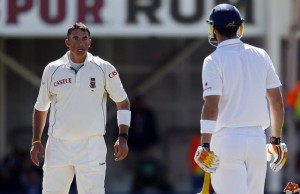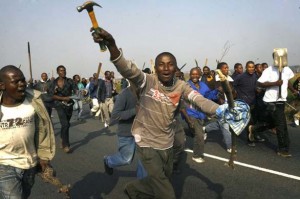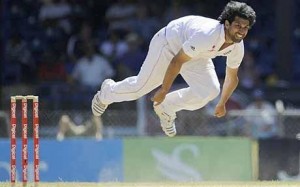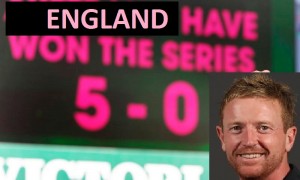
A gradual but inevitable descent into cricket-based loathing and bile.
One Of The Great What Ifs, #5: Kevin Pietersen Played For South Africa
We imagine that in the past weeks few people have been searched for on Google as much as Kevin Pietersen. Possibly Margot Robbie. But surely no-one else. Amongst the desire for tittle-tattle (Pietersen) and titties (Robbie), is a need to review his career, to remember how strange it was. It is no surprise that Pietersen divides opinion and no surprise that for journalists “he makes good copy”, but his journey from youth to veteran was a crooked path that rarely failed to attract attention.
But what if he hadn’t moved to England to play for Nottinghamshire in the 2001 season? What if he had remained in South Africa and fought to further his career there?
The first assumption we make is that Pietersen stayed at KwaZulu-Natal and managed to force his way into the team around the 2001-2002 period. The second is that his form was similar to that at Nottinghamshire, which was consistently very good from his debut until he qualified for England in 2004. South Africa had plenty of batsmen to choose from in this era, although only two of their regular selections were born within a four-year period from June 1978 to June 1982 (i.e. two years either side of Pietersen’s birth) – Graeme Smith and Jacques Rudolph – seven and eleven months junior to Pietersen respectively.
South Africa
Pietersen was regularly mentioned as a candidate for international selection throughout 2002 and 2003, but the selectors controversially preferred to hand a Test debut to Rudolph against Bangladesh. It was later in the same year that he eventually received a call-up – firstly to the ODI team as they rebuilt after the World Cup and then to the Test side against the West Indies in place of Neil McKenzie. A pair of 50s on his debut were impressive and his form continued away to New Zealand, making his maiden Test century in Gary Kirsten’s final match. Infamously, Pietersen also had his first spat with a team-mate, but that it was an argument with Andre Nel rendered it – at the time – irrelevant.
The following winter Pietersen starred in the epic series at home to England, but whilst the tourists were wrapping up a 2-1 victory thanks to Andrew Strauss and Matthew Hoggard, Pietersen was already growing frustrated by his compatriots. Rumours circulated of him falling out with captain Smith and forming a weirdly close relationship with the opposition. There was further controversy a year later when after a run of low scores he was replaced in the team by Hashim Amla.
His career continued to promise much, but for every major contribution (158 on his recall against New Zealand) there was an embarrassing dismissal. Indeed it was only really in the ODI team that he flourished – his combination of tight spin bowling and lower order hitting taking South Africa all the way to the World Cup final in 2007. Unfortunately his tournament was mostly remembered for being caught in the deep off the bowling of Sanath Jayasuriya as Sri Lanka wrapped up their second World Cup win. Indeed the manner of his downfall led to much outcry in South Africa – as well as the first of his high profile falling outs with Mickey Arthur.
As Pietersen entered his late 20s he could still not hold down a regular place in the Test team, notwithstanding continuing success in the ODI and T20 team. But early in 2010 came the turning point: the mini series in India. Batting at number six he contributed in each innings he batted (including a match saving 150 at Kolkata), and his bowling was at least equal to Paul Harris’s. For the next four years he formed part of a mighty batting order – Amla, Kallis, DeVilliers, Pietersen – that took South Africa to number one in the rankings, winning nine consecutive series along the way. South Africa’s relatively few Test matches allowed him to star in various T20 tournaments whilst avoiding any significant injury. Meanwhile his bowling, whilst never match-winning, was a good enough foil for the pace attack.
Now, at the time of writing, Pietersen stands on the brink. Jacques Kallis has gone, meaning the balance of a spinning all-rounder is as important as ever. Moreover, rumours circulate of Smith passing on the captain’s armband – with Pietersen leading the race to take on that particular responsibility. At 33 he would be a relatively old appointee, but there seems to be plenty of hunger and life in him yet.
England
As for England? Well Graham Thorpe continued his Test career in the 2005 Ashes and was instrumental in the series victory with pragmatic and obdurate batting throughout. He continued to thrive for a further 18 months, top scoring for England in both their subcontinental tours of 2005/06 and hitting a famous hundred on his home ground against Pakistan as England completed a whitewash. As senior pro on the next Ashes tour he was a welcome sage for the inexperienced Andrew Flintoff and England battled hard against a resurgent Australia. During the course of the series he notched his 8,000th Test run, before bowing out with a brilliant 160 (his 21st Test century) at the SCG in a losing cause as England just failed to retain the urn.
With Thorpe’s retirement – and the mutually-consented departure of Duncan Fletcher – a period of transition became upon England. Michael Vaughan’s injuries made it difficult to keep a settled batting line-up and his own retirement in 2008 should have triggered a new era. But Andrew Strauss and Peter Moores were hindered by an inexperienced middle order: Ian Bell, long identified as a No. 3, was unable to turn promising starts into big scores; Paul Collingwood was forced to bat at an uncomfortably high No. 4; the young talent Ravi Bopara was unsuccessful and in 2009 England resorted to giving a recall to Mark Ramprakash which ended embarrassingly with a run of scores of 0, 1, 0 and 27. The undoubted nadir though was the 2009 tour to the West Indies, which included the infamous first Test in which England were bowled out for 50.
England, it is fair to say, were in turmoil. The ECB had invested heavily in Peter Moores and were reluctant to sack him. Andrew Strauss was regarded as England’s best batsman and an intelligent man, but his defensive style of leadership led to criticism as they lost the home Ashes heavily. He announced his resignation at the Oval and the management were quick to install Collingwood in his place. It was an inspired change. In all forms of the game Collingwood was able to improve his batting with his place in the side now assured; meanwhile Strauss, unencumbered by shouldering the blame in defeat, rekindled his own form. Although Test series victories were still rare, the limited overs side flourished. Not only did they win the 2010 World T20 (Owais Shah scoring heavily at number three) but their performances in the 2011 World Cup were as good as they’d been for 20 years.
Playing bold and attacking cricket, Collingwood’s men became immensely popular around the world. They might not have been consistent – losing the Brisbane Test in 2010 by an innings was a notable low point – but when they won it was often a fantastic and thrilling victory. It was a vibrant team with youngsters such as Eoin Morgan and James Taylor adding flair and excitement to the mix. By 2013 the side were growing in maturity, meaning they were less inclined to lose matches from winning positions. After excitingly winning the home Ashes 2-1, they travelled down under. Frankly the rest is history. But we’ll never tire of repeating it: England 5 Australia 0. The Paul and Peter Show had delivered what it had been promising for years and they both headed off for pastures new after the fifth Test at Sydney.






No Comments
Post a Comment